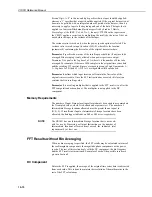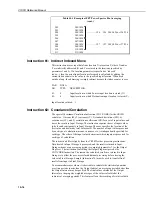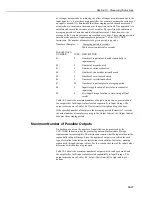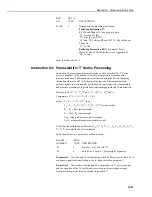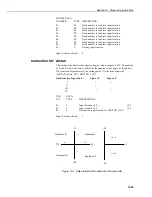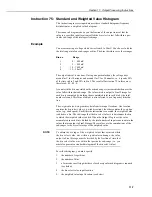
CR10X Reference Manual
10-20
N
is the number of input samples in the specified averaging period
(Parameter 7)
N'
is the number of input scans in the last averaging period
NT
is the total number of input samples processed in the Output Interval
Intermediate storage requirements
The number of Intermediate locations will depend upon the number of input
values and outputs desired:
1.
Define K as the number of input values.
2.
Define S as the maximum of either the variances, standard deviations, or C,
where C = K if K < the number of correlations requested, or C = number of
correl 1 if K > the number of correlations requested.
3.
Define Q as the maximum of either the covariances or correlations
desired.
4.
Define P as the total number of outputs desired.
The amount of intermediate memory locations (IML) required, is then given by:
IML = K + S + Q + P + 2
Execution time
If K, S and Q are defined as in the previous section, the execution time of the
COV/CORR Instruction in milliseconds can be approximated by:
T(ms) = 1.1K + 0.5S + 0.9Q + 1.8
When evaluating how frequently input samples can be processed by the
COV/CORR instruction (i.e. determining the minimum program table execution
interval), the time required to make the measurements and order the input values
must be added to the COV/CORR execution time. Two alternatives exist for the
measurement portion of the programming. The fastest method is to group as many
sensors as possible into the fewest measurement instructions, ignoring the input
location order required by the COV/CORR Instruction. After the measurements are
made, use ‘move’ instructions (i.e. 31 and 54) to obtain the proper input order. The
slower alternative is to order separate measurement instructions directly as required
by the COV/CORR Instruction. While avoiding ‘move’ instructions, this approach
uses more measurement instructions. The reason the first method is in general
faster is that less overhead time is required in going from one measurement to
another within a single instruction (using the ‘repetitions’ feature) than in going
from one measurement instruction to another.
In many situations, the CR10X must perform measurement and processing tasks
in addition to those associated with the COV/CORR Instruction. Uninterrupted
operation of the COV/CORR Instruction is assured by entering it in Program
Table 1 (highest priority) and placing the additional tasks in Program Table 2.
A covariance/correlation example is given in Section 8.
Instruction 63: Parameter Extension
This instruction is used immediately following Instruction 97 or 98 to allow the
entry of a variable number of parameters. Instruction 63 can be entered several
times in sequence if the number of parameters requires it. There are eight 2-digit
parameters. Refer to the instruction being extended (97 or 98) for further details
on the use of Instruction 63.







